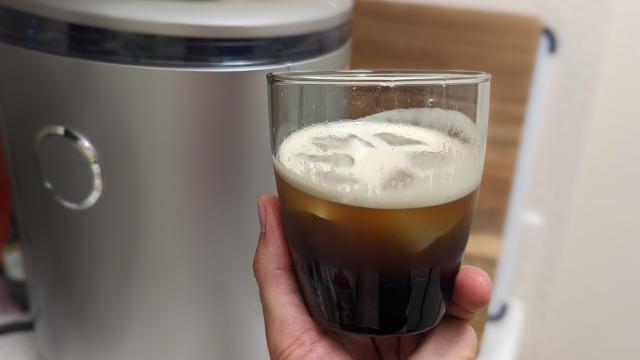I love a good cup of coffee, but if I’m going to a café, I’ll almost always get an espresso drink of some sort. Usually, it’s a cappuccino or a flat white (I’m basic like that), and I think it’s because it feels special, like a treat. This is probably because I’ve never had the space in my kitchen (let alone money) for a good espresso setup plus my gear for regular coffee, and I refuse to buy into one of those damn pod systems. But now, suddenly, there’s this silver ovoid on my kitchen counter that makes any coffee drink I want, and I don’t want to go back.
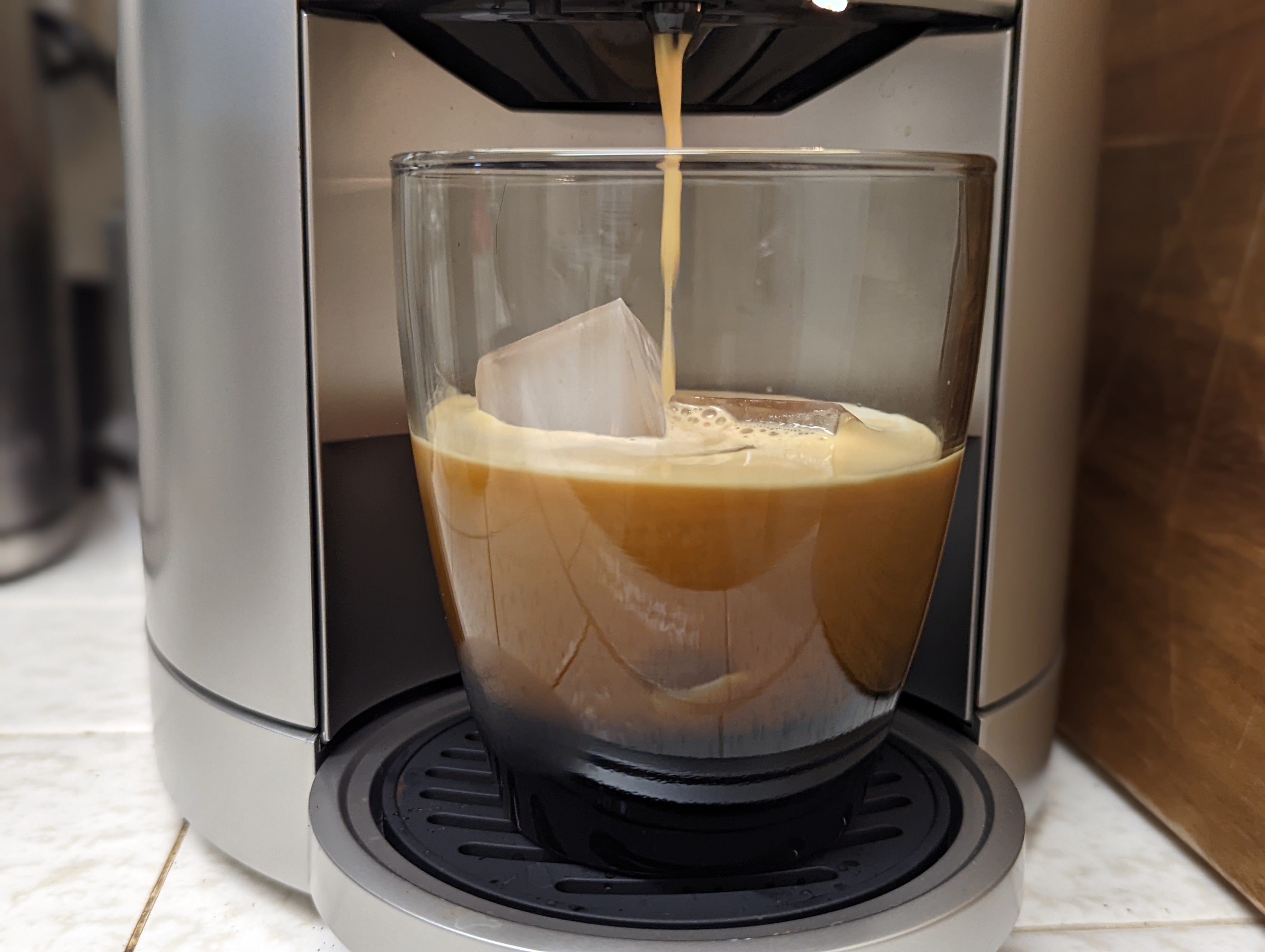
Spinn Coffee Maker
What is it?
A coffee maker that uses centrifugal force to make both espresso and regular coffee
Price
Starts at $US1,000 (no AU pricing yet)
Like
The drinks taste fresh and amazing, no plastic pod waste, can start brewing from bed, makes a wide variety of drinks, all of which are tweakable, very automatic and easy to clean, and the milk frother produces excellent foam.
Dislike
Not cheap, some recipes need some tweaking depending on your beans, can’t use super dark/oily beans, milk frother is good but not so customisable, some mandatory maintenance costs, still some bugs/errors in the app and machine.
The Spinn is not vaporware
The Spinn Coffee Maker was one of those Kickstarter projects that just seemed destined to be vaporware. It made huge promises, and it took several years before it started shipping to backers, but now it’s readily available to anyone, and it actually delivers on most of its aspirations. Basically, it’s an automated, beans-to-cup, coffee and espresso maker. If you’re wondering how the hell it can make both coffee and espresso drinks, the answer is centrifugal brewing.
Basically, it works like this: you select the coffee drink that you want to make, either in the app on your phone or with one of the seven presets on the machine itself (four of which are customisable). Beans drop down from the hopper on top and into the stainless-steel burr grinder. It will adjust the coarseness of the grind to suit the drink you ordered (more coarse for coffee, finer for espresso) down to 0.01 inch grains. Those grounds drop into a small basket that spins really, really fast (up to 5,000RPM) while multiple nozzles inside spray it with hot water. This is where Spinn gets its name. That centrifugal force actually creates enough pressure to pull that hot water through the beans, so what comes out of the spout and into your cup is a dark, frothy espresso that looks like it was pulled in a high-end café. Or, you can just do a plain old nice cup of black coffee, or even a reasonable approximation of a cold brew, depending on what drink you selected.

The device itself is 13.5 inches tall, 8.5 inches wide, and 14 inches deep. While I love kitchen gadgets, finding the necessary counter space for them is always an issue for me. Fortunately, the machine tucks nicely into a corner with plenty of clearance under the cabinet above it, and ultimately it ends up taking up about as much space or less as my previous coffee setup (which included an electric kettle, a Bodum pour-over carafe, and an Aeropress with all its accoutrements). For such a complex device, I was surprised that it only took me a few minutes to set it up. I basically just plugged it in, got it onto my Wi-Fi network via the app, and while the firmware was updating, I rinsed out the water tank and installed the filter (which works like a Britta to filter out some of the nasty stuff in tap water for an improved taste), then it was ready to go.
Once you’re set-up, you dump fresh beans into the hopper on top, which can hold up to 18 ounces (I’d just dump in a one-pound bag). The water panel in the back tilts back and lifts off, so you can just hold it under your faucet and then pop it back in. It has a built-in drip tray that slides out for easy dumping. One of the things I like the most about it is the tray for the used grounds. First off, the grounds are extremely dry by the time they go into the tray (thanks to all the spinning), so they are light and don’t mould quickly. Second, there’s no plastic pod or aluminium foil to dispose of. You can just dump the spent grounds on your plants (which they seem to enjoy) and you’re good.
Of course, there’s a Spinn app
The app has a fair amount going on, too. For starters, you can order coffee through it. While Spinn was working on getting this machine together, it managed to establish itself as a sort of emporium for local coffee roasters with its Spinn Marketplace. You can take a “coffee quiz” within the app to dial in what flavours you like and your drinking habits, and then it will recommend some roasts you might enjoy (you can even narrow it down to local roasters in your area). There’s a positive and negative side to this. The negative is that these tend to be pricey beans, and you’re adding shipping costs to them. The positive is that some roasters have worked with Spinn on refining recipes for different roasts they make, so when you get a bag of one of these coffees, you scan it with the app, and when you make a cup of coffee, the machine will have preloaded the roaster’s recommended settings for amount of water, amount of beans, etc. The idea here is that roasters have no control once the beans leave their warehouse, but this lets you taste their coffee exactly as they designed it to be, and then you can tweak those recipes to your liking.
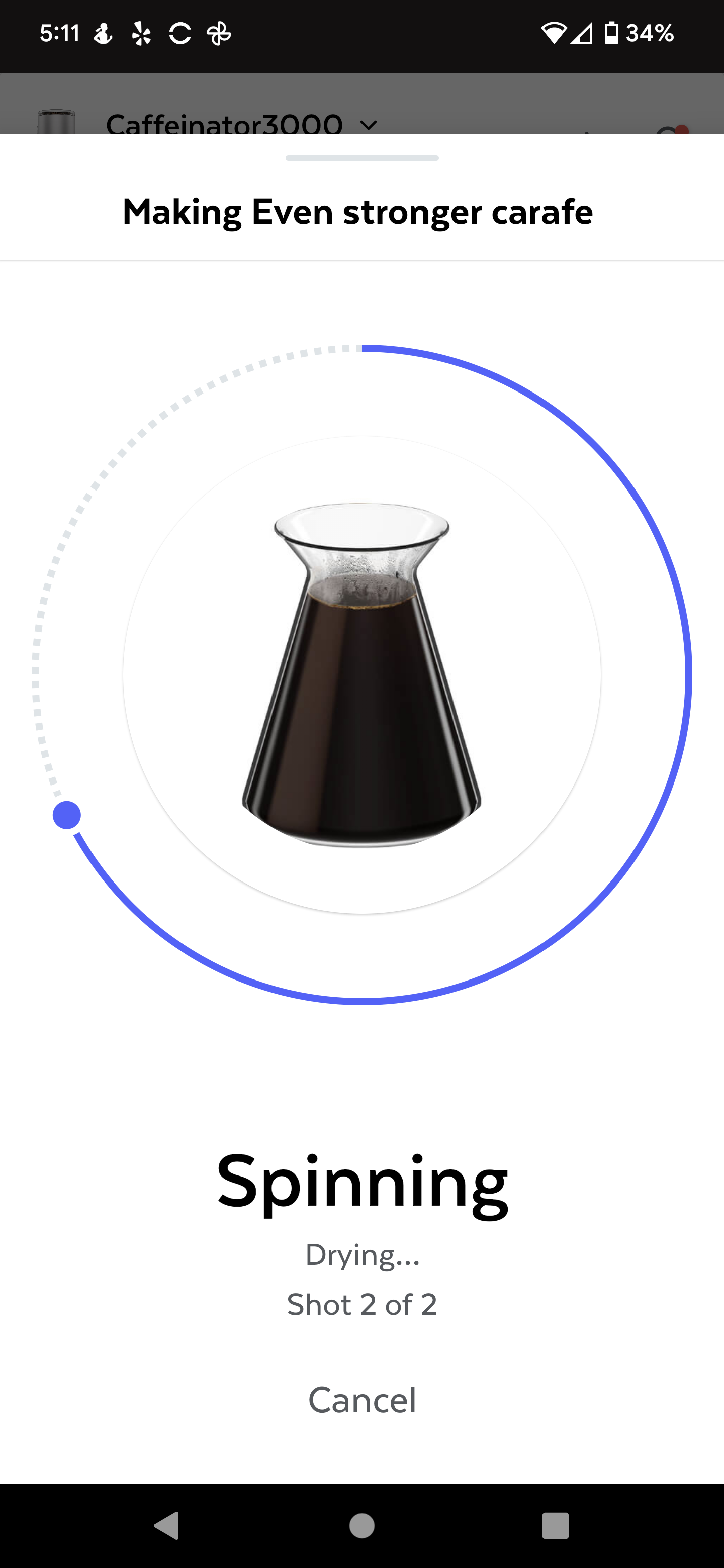
From within the app, you can select any recipe (there are more than two dozen) and adjust a couple of the parameters: typically just the amount of grounds and amount of water. For example, for a ristretto (the small but sweet shot that’s the heart of any cappuccino, latte, etc), the default is 12 grams of coffee to make a 1 fluid once shot. For a lighter roast, though, you might want to increase the amount of water so it doesn’t come across as sour (which some light roasts can). For a ristretto, you can adjust the coffee to anywhere between 10 and 15 grams, and the water to between 0.7 and 2.2 fluid ounces. Being able to make those precise adjustments is very appealing to coffee nerds, and it’s amazing how much those little changes can alter the flavours in your cup.
Ultimately, I’d like to see Spinn add a Pro/Geek Mode with even more parameters to play with (including grind size, water temperature, and spin rate), but for now that stuff is under lock and key. It is something the machine does in the background, though. For example, coffee will be ground a bit coarser, and it will only be spun at 1,500RPM, while espresso will be fine-ground and get cranked up to 4,500RPM, and cold brew, of course, will use unheated water.
Does the Spinn brew good coffee?
Of course, none of this matters at all if the coffee doesn’t actually taste good. Thankfully, it does. In fact, it’s really good. I would say the star of the show here is the espresso drinks. Grinding the beans seconds before you use them definitely adds to the freshness, then the Spinn does a great job at extracting all the flavours from those beans. The espresso and ristretto have a silky, luxurious crema (read: coffee foam) at the top as you’d see in a high-end café, and they’re absolutely delicious. It also only takes about a minute to whip it up, so typically I’ll leave a cup in place the night before. Then I just tap the drink I want in the app before I get out of bed, and by the time I get to the kitchen, the drink is ready for me. The burr grinder isn’t exactly quiet, but it isn’t overly loud, either, and the spinning basket doesn’t make much noise at all.
I ultimately ended up getting really good standard coffee out of the Spinn, too, but that was slightly less straightforward. While the beans I started with did come from the Spinn Marketplace, the roaster hadn’t yet set up its ideal settings for them, so when I used the default coffee setting, it came out tasting a bit thin and under-extracted. It wasn’t bad, but I wanted something a bit bolder. So, I just fiddled with the sliders in the app to control the amount of coffee and amount of water until I found the flavour I was looking for, and then I named and saved that recipe for future use. Once you’ve got it dialled, your coffee will taste the exact same way every time. I’ve never had that kind of consistency at home.

The one brew type that I would classify as “just ok” are the cold brews. There are two types of cold brew modes: Nitro and Drip. The nitro version is fast (about one minute), uses high RPM, and has that creamy foam on top you’d get from a real nitro cold brew. The drip version uses a lower RPM, slowly adds water, and lets it pull through, which ends up taking a few minutes to complete. The default settings for both leave a bit to be desired. They’re refreshing, but a bit too watery. I was able to dial in the settings (increasing the amount of coffee used) to make them taste really quite good, but I don’t think it’s quite a full substitute for real cold brew. For only taking one minute, though, it’s a decent impression.
Incidentally, for testing, I started with Southern Weather from Onyx Coffee and Midnight Roast Decaf from Espresso Republic, both of which I bought off the Spinn Marketplace. The app recognised both bags, but unfortunately, the roasters hadn’t set up specific profiles for them. When I ran out of those, I switched to Fire Department Coffee’s Shellback Espresso and Decaf Medium Roast (10-per cent of proceeds go to injured first responders), and finally Peet’s Decaffeinated Mocca Java. While I’ve always known that yeah, duh, different beans and roasts taste different, I’ve never had such a precise way of making coffee before, so for the first time, I was able to have the beans be the only variable that changed. It makes for a much more scientific taste test if you wanna be severely geeky about it. I also enjoyed tweaking ratios until I found the sweet spot for each bean/recipe and saved them for later.
Spinn’s milk frother isn’t perfect, but buy it anyway
One thing I haven’t brought up yet is the milk, which is obviously an important component for a lot of these espresso drinks. The Spinn doesn’t have a milk frother built into it. Instead, you can buy one bundled with the Spinn for an additional $US50 (or $US100 if you buy it separately). I ended up testing the Pro package, which included the milk frother as well as a carafe. The frother is an 8-inch-tall by 3.75-inch-wide silver cylinder that looks good next to the Spinn. You just pour milk in up to one of the lines on the inside (the app tells you which line, based on which drink you’re making), and press the button. It has three modes: Hot foam, warm milk, or cold foam, and you just press the button once, twice, or thrice to select which. It whips the milk up in under a minute, then you lift it off the base (which plugs into the wall), and pour it into your coffee drink. It’s non-stick on the inside, so typically I just rinse it out in the sink for a few seconds and pop it back onto the base. You definitely get the best foam with whole milk, but I’ve had varying degrees of success with various alt-milks (thicker, “barista style” oat milk comes in second).
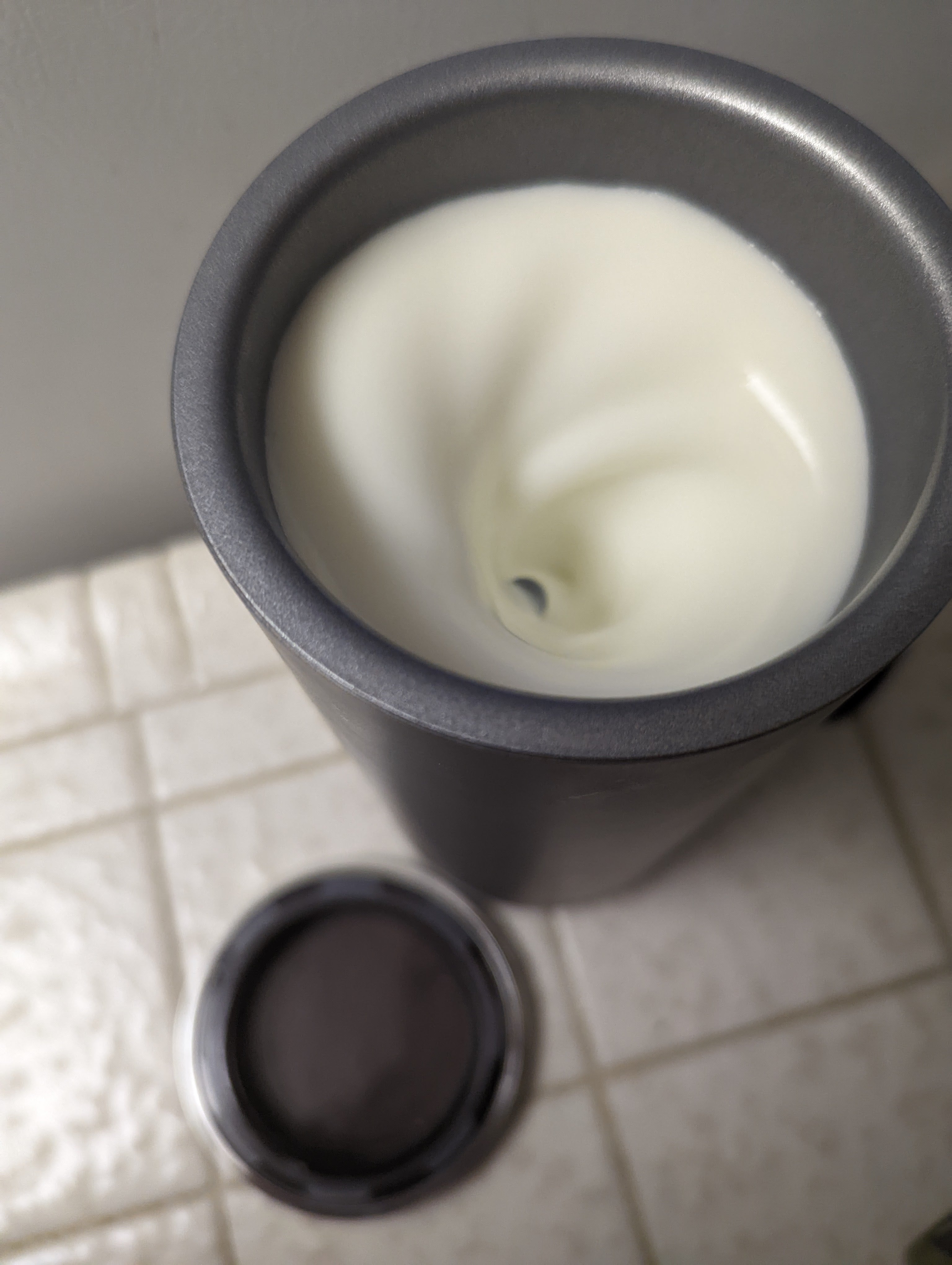
The frother works well, but it isn’t perfect. If you want very thick, rich foam like for a cappuccino or a macchiato, it’s absolutely fantastic. The problem is for a drink like a cortado, where you want mostly warm milk and just a little foam — there isn’t really a setting for that. You’d have to pull out the whisk to use the milk warming mode, and then put it back in (getting your fingers a bit milky) and froth it for just a few seconds. Not ideal.
Some recipes will tell you to remove a few spoonfuls of milk before you pour, which works alright for a flat white where you have 4-5 ounces of milk, but less so for the cortado, where you only have two ounces, and it ends up being all foam. It’s tasty, but it’s not really a cortado (which is supposed to have equal parts espresso and hot milk). Sometimes I’ll give it a little stir or swirl if the foam is too thick. I wouldn’t call this a dealbreaker, but considering it’s being paired with arguably the most customisable coffee maker I’ve seen, it is weird that the frother isn’t a bit smarter. Also, the frother doesn’t have a spout, which effectively crushes all of my latte foam-art-making dreams, and the foam is often so thick that it can be hard to pour. Those gripes aside, I still like it a lot and continue to use the thing at least once or twice a day.
Not for tea
If this review has sounded a bit too rosy, let me assure you that there are indeed some pain points. While I appreciate that the Spinn is fairly compact, the 1,133.98 g water reservoir runs out pretty quickly. If your device lives under a cabinet, that makes it a little tricky to slide out, refill, and put back in. The Pro version actually allows you to plumb into your water line, which should eliminate that issue, but as an apartment renter, I decided against drilling into my countertops (though if I owned the place, I’d definitely go for it). While the machine can pour you a cup of plain old hot water, it doesn’t really replace a kettle, because it actually takes several minutes to make a single cup of hot water. More importantly, that water only ends up being 80 degrees Celsius, which is too cool for brewing many types of tea (and well short of the 100 degrees needed for boiling).
The machine does a sort of rinsing/ self-cleaning process around five or ten minutes after you brew your last cup. This involves running some water through the system, which comes through the spout and lands in the drip tray. Unfortunately, this means that you can’t just grab your full cup of coffee and immediately replace it with an empty cup so it’s ready to go for next time (I did that the first day and was surprised that I kept coming back to a glass with a bit of dirty water in it). That also means the drip tray fills up faster than you’d think and has to be emptied more often than you’d like (once every day or two, depending on how much coffee you’re making). It’s quick and easy to do, but the machine won’t start brewing if the drip tray is full, so it can be a bit annoying.
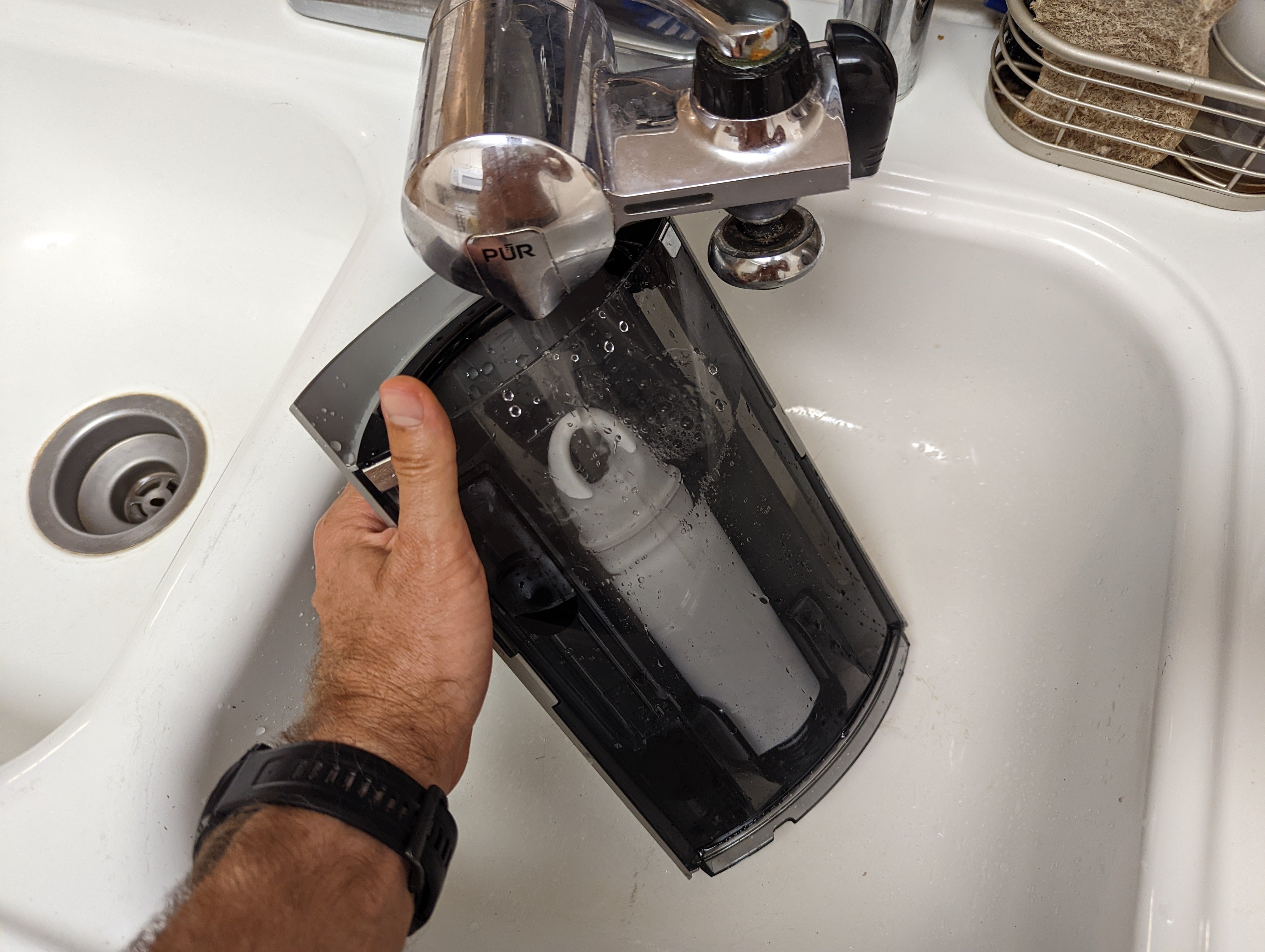
It also has some of the trappings you’d expect from a very complex first-generation device that was just released. This comes in the form of occasional machine errors (though nothing appears to be going wrong), and a lot of odd behaviour in the app, like when I got a notification but clicking it didn’t take me anywhere (at least on Android). Generally, the app looks good, but it’s got some bugs that still need to be ironed out.
Speaking of the app, while a handful of roasters have put in their optimum settings, most of the beans you can buy on the Spinn Marketplace don’t have bespoke settings yet. In the meantime, you’re advised not to select beans that are too dark or oily, as those can gum up the device. As someone who really likes dark roasts, this was disappointing, but I’ve found that I can actually use pretty dark beans (including my favourite mocca java) without any apparent hiccups.
The app does have an Alexa Skill, so you can tell your Alexa to make you a cold-brew, or make an espresso, and it actually works, if not with 100-per cent reliability. Unfortunately, Google Assistant runs the show at my house, and Spinn doesn’t yet support either it or Apple’s Siri, though I’ve been told more integrations are on the roadmap.
Then there’s the price. Spinn is coming in hot at $US1,000 for the basic model, $US1,050 for the version with the milk frother (definitely recommended), and $US1,200 for the Pro Bundle, which has the frother, carafe, a travel mug, and is water-line compatible. Not cheap! There’s also a kit of fluids you need to buy for monthly maintenance ($US32 for every six months’ worth), and you’re supposed to change the proprietary water filter every two months or 1,000 cups of coffee ($US26 each, not including shipping). These things do add up. But then again, so do all those damn $US5 coffee drinks I buy, and I can easily see myself making two hundred drinks with this machine in the first six months alone.
Should I buy the Spinn coffee maker?
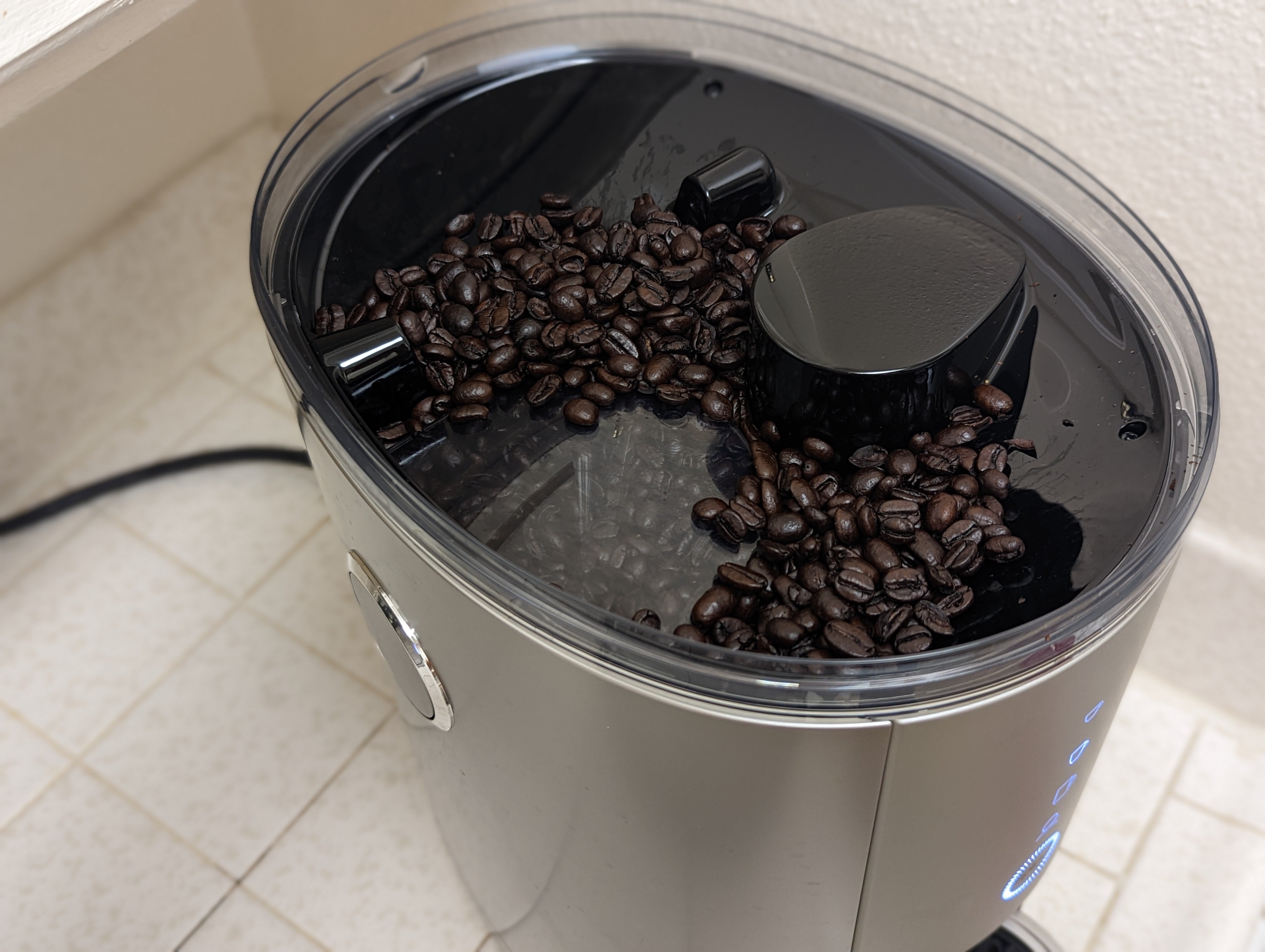
Overall, I have to admit that I love this thing. I’ve been testing it for two months now, and while it has its quirks and imperfections, many have already been ironed out through software and firmware updates. Moreover, the coffee drinks coming out of this thing still feel special. I love that there are so many types of drinks (all of which can be tweaked to my liking), that it’s super-fast, that I can make coffee from my bed, and that it’s virtually impossible for me to screw it up (you should see some of the Aeropress accidents I’ve had). Plus, I don’t have to deal with grinding my own beans, the flavours are amazing, and there are no wretched pods ending up in landfills. Basically, it has even more convenience than a pod machine, and much, much better flavour. For a product that seemed like it was going to be vaporware, it ended up being pretty damn solid.
Editor’s Note: Release dates and prices within this article are based in the U.S., but will be updated with local Australian dates and pricing as soon as we know more.
